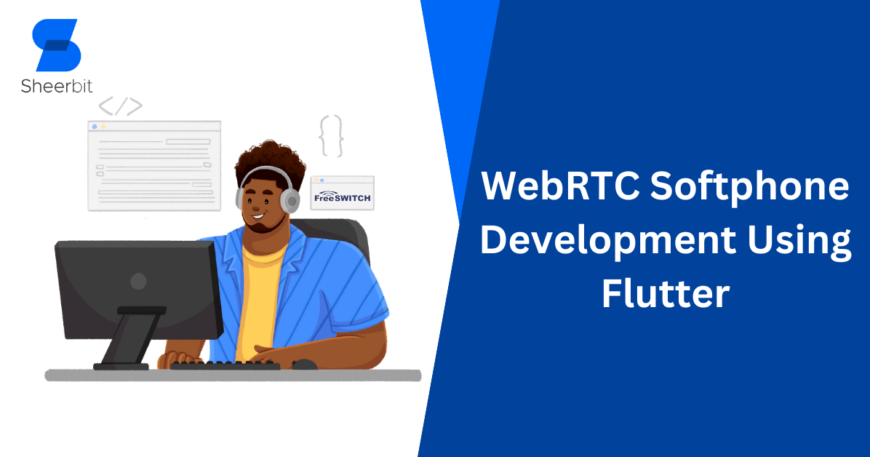Communication is essential in the fast-paced world of today, and there has never been a need for real-time, high-quality audio and video communications. How we communicate online has been completely transformed by WebRTC (Web Real-Time Communication) technology, whether we use it for personal or professional purposes. Peer-to-peer audio and video communication may be supported natively in web browsers and mobile apps using WebRTC; Flutter is a well-liked framework for developing mobile apps.
This piece will explore the fascinating realm of developing WebRTC Softphone Development using Flutter. This session will cover the definition of WebRTC, go over the benefits of developing mobile apps using Flutter, and demonstrate how to use it to create a WebRTC softphone application.
Chapter 1: Understanding WebRTC
What is WebRTC?
The open-source WebRTC project enables programmers to add audio and video capabilities for real-time communication to web and mobile apps. WebRTC stands for Web Real-Time Communication. To create interactive communication apps that work across several platforms, including mobile apps and web browsers, it offers a collection of APIs and protocols. Because of its flexibility and user-friendliness, WebRTC has become incredibly popular.
Key Components of WebRTC
1. MediaStream: The audio and video feeds from webcams and microphones are captured by this API.
2. RTCPeerConnection: It is in charge of setting up and maintaining peer-to-peer connections, which allow for safe data transfer.
3. RTCDataChannel: With the help of this component, developers may establish bidirectional, low-latency data channels between peers.
Advantages of WebRTC
WebRTC is a desirable option for real-time communication applications because of its many benefits:
1. Cross-Platform Compatibility: WebRTC is a flexible solution for developers since it works with many platforms, including web browsers, Android, iOS, and more.
2. Security: WebRTC ensures safe data transmission by encrypting communication using industry-standard protocols like DTLS and SRTP.
3. Low Latency: WebRTC ensures low latency in audio and video transmission since it is built for real-time communication.
4. Easy Integration: Developers may easily use the WebRTC APIs because they are reasonably simple and have comprehensive documentation.
Chapter 2: The Power of Flutter
Google developed the open-source Flutter user interface development tool. Because of how simple it is to use and how one codebase can be used to create natively built desktop, online, and mobile apps, it has become more popular among developers. Now, let us examine some of the main advantages of using Flutter in mobile app development:
Advantages of Flutter
1. Single Codebase: You can build a single codebase for both iOS and Android apps using Flutter, which cuts down on the time and effort required for development.
2. High Performance: Because of the Ahead-of-Time (AOT) compilation and the usage of the Dart programming language, Flutter apps are renowned for their outstanding performance.
3. Rich Set of Widgets: A vast array of configurable widgets offered by Flutter facilitates the creation of aesthetically pleasing and intuitive user interfaces.
4. Hot Reload: The Hot Reload function is highly favoured by developers since it allows them to view their changes instantly, expediting the development process.
5. Community and Ecosystem: With a thriving and expanding community, Flutter offers a wide range of packages and libraries for different capabilities.
Chapter 3: Building a WebRTC Softphone App with Flutter
Let’s get started developing a WebRTC softphone app using Flutter now that we have a basic grasp of the technology and the benefits of utilizing it for mobile app development. We’ll divide this into a few essential steps:
Step 1: Setting up Your Development Environment
Ensure Flutter and all required dependencies are installed on your computer before starting. The official Flutter website offers detailed setup instructions for configuring your programming environment.
Step 2: Creating a Flutter Project
The command to start a new Flutter project is as follows:
flutter create webrtc_softphone
With the name “webrtc_softphone,” this script creates a new Flutter project directory.
Step 3: Adding WebRTC Plugin
To add WebRTC capability to your Flutter application, you will need to install a WebRTC plugin. Using the `flutter_webrtc` plugin is a standard option. Add it to the dependencies section of your `pubspec.yaml` file:
dependencies:
flutter:
sdk: Flutter
flutter_webrtc: ^0.8.4
To retrieve the package, do `flutter pub get}.
Step 4: Building the User Interface
Create the softphone app’s user interface. With the help of Flutter’s widgets, you can design a simple, user-friendly call setup.
Step 5: Implementing WebRTC Functions
You must write routines for initializing audio and video streams, controlling peer connections, and handling call signaling to construct WebRTC connections.
Step 6: Handling Signaling
Signaling is essential for establishing connections and controlling call statuses in real-time communication software. There are other ways to implement signaling, such as utilizing WebSocket or a dedicated server.
Step 7: Testing and Debugging
To make sure your softphone app functions correctly, it is imperative that you extensively test it. The Hot Reload function in Flutter expedites the debugging process.
Step 8: Deployment
Once it’s ready, you can publish your program on the Google Play Store and the Apple Program Store for users to download and use.
Chapter 4: Challenges and Considerations
Although creating a WebRTC softphone application using Flutter is a fun project, there are a few difficulties and things to think about:
Device Compatibility: The WebRTC functionalities may not be supported by all devices. Make sure your app functions correctly on a variety of instruments.
Network Conditions: Network circumstances have a significant role in real-time communication. Adapting gracefully to inadequate connection is crucial.
Security: Although WebRTC offers encryption, you still need to put security measures in place to guard against any weaknesses.
UX Design: For your softphone app to provide a good user experience, you must design an intuitive and user-friendly UI.
Conclusion
Developing WebRTC softphones with Flutter is a potent combo that lets you create real-time communication applications of superior quality for a broad user base. WebRTC’s capabilities combined with Flutter’s ease of development allow for the rapid creation of feature-rich softphone applications that facilitate worldwide communication.
When you set out to design a WebRTC Softphone Development, remember to keep abreast of Flutter and WebRTC advancements, use the helpful communities, and test and improve your app often. In the field of real-time communication, you have a significant influence if you have the correct tools and methods.
So, why do you hesitate? Launch a WebRTC Softphone Development with Flutter right now to provide your users with smooth communication at their fingertips.





